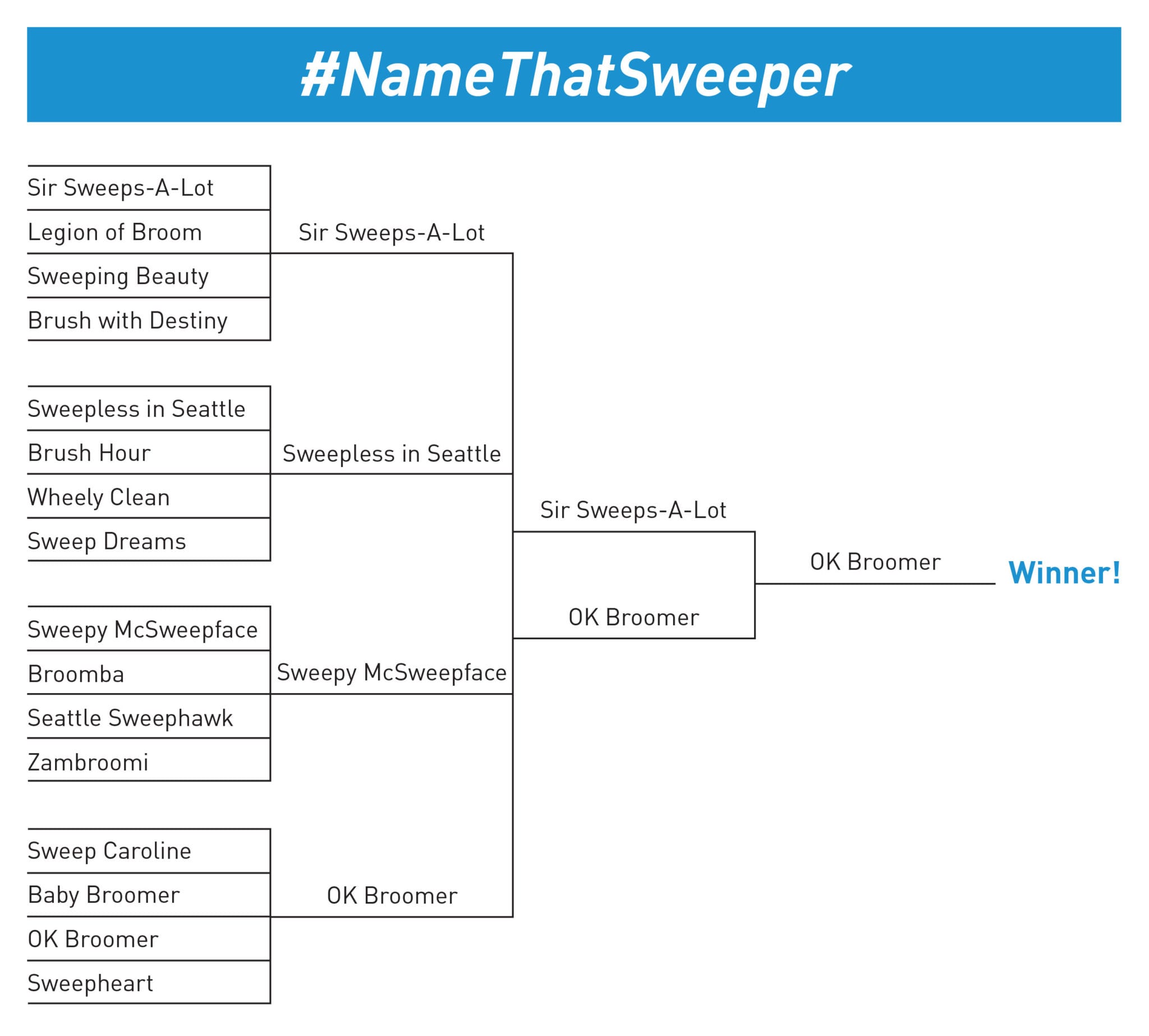
We’d like to formally introduce you to our protected bike lane sweeper. Meet OK Broomer! The name was introduced by a 11-year-old boy named Pascal from the Licton Springs neighborhood of Seattle.
THANK YOU to the more than 1,500 people who voted in our twitter polls and helped #NameThatSweeper
We recently asked you to help us come up with a name for our new protected bike lane sweeper. You really swept us away with all of your creative ideas.
We went through all of your suggestions and narrowed them down to our sweep sixteen finalists. We received so many great ideas, but had to choose sixteen because of the limitations of voting on Twitter.

Here’s how the voting works:
All voting will take place on the @seattledot Twitter.
- Sweep sixteen: Tuesday (5/18), we’ll post four Twitter polls (one for each bracket group) and we need you to vote for your favorite name in each one. The polls will be open for 24 hours. The four winners will move on to the final four round of voting!
- Final four: On Thursday (5/20) we’ll post a Twitter poll for the final four names. The top two names from this round will move on to the championship round.
- Championship: On Monday (5/24) we’ll post a Twitter poll for the top two names and announce the winner on Tuesday!
All polls are only open for 24 hours!
We’re bristling with excitement to see which name sweeps the competition and which ones get brushed under the rug!

The protected bike lane sweeper is a mini version of our street sweepers and is designed to fit perfectly in our protected bike lanes.
SDOT and Seattle Public Utilities work together to sweep over 26,000 broom-miles of street each year. Broom-miles are the total miles that the operators sweep. We have about 40 routes of different lengths that are swept at different frequencies. On average, we sweep up around 5,000 tons of debris annually! This prevents over 150 tons of pollutants like metals, nutrients, tire dust, and plastics from entering our waterways.
Keeping our streets and protected bike lanes clear of debris increases safety for everyone and is good for the environment!
Street and bike lane sweeping removes leaves, trash, and city grit to make our streets cleaner and improves safety for people who bike, walk, roll, or drive.
Street sweeping also helps keeps storm drains clear of leaves and debris. When storm drains are blocked, water can accumulate in the street and increase flooding risks. And, when the temperatures drop, standing water on the streets can quickly turn to ice.
When the storm drains are clear and functioning, water from our streets flows directly to our creeks, lakes, rivers, and Puget Sound. Regular street sweeping removes harmful pollutants from our streets so they aren’t carried to our waterways. These pollutants include copper from brake pads, zinc from tires, and nickel and chromium from engines. These metals are harmful to fish, even in very low amounts. Leaves and other plants can be a problem, too. When leaves accumulate in the street, they may wash into the water. Their nutrients can cause algae growth, which harms fish and other aquatic life.

Want to know when street sweepers will be in your area? Check out the street sweeping website and route map!
Here’s what you can do to keep our streets and local bodies of water clean and help the street sweepers do their job:
- Move your car from the street on the scheduled sweeping date and organize your neighbors to do the same. This allows the sweepers to get closer to the curb, where much of the debris and pollutants accumulate.
- Wash your car at a designated car wash or in your yard. Soapy and dirty wash water might otherwise drain to and pollute the local lakes or Puget Sound.
- Maintain your car so that it doesn’t leak fluids.
- Adopt a drain near your residence or work. Sweepers may not always reach all areas of the street, and assisting by keeping the storm drain clear of debris helps prevent flooding during rain storms.